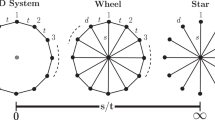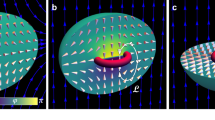Abstract
Observations of Bose–Einstein condensates—macroscopic populations of ultracold atoms occupying a single quantum state—in dilute alkali-metal and hydrogen gases have stimulated a great deal of research into the statistical physics of weakly interacting quantum degenerate systems1,2. Recent experiments offer a means of exploring fundamental low-temperature physics in a controllable manner. A current experimental goal in the study of trapped Bose gases is the observation of superfluid-like behaviour, analogous to the persistent currents seen in superfluid liquid helium which flow without observable viscosity. The ‘super’ properties of Bose-condensed systems occur because the macroscopic occupation of a quantized mode provides a stabilizing mechanism that inhibits decay through thermal relaxation3. Here we show how to selectively generate superfluid vortex modes with different angular momenta in a Bose–Einstein condensate. Our approach involves solving the time-dependent equation of motion of a two-component condensate with strongly coupled internal atomic states, as recently investigated experimentally4,5. The generation of vortices relies on the coupling between the states (achieved by applying an electromagnetic field), combined with mechanical rotation of the trapping potentials which confine the condensate.
This is a preview of subscription content, access via your institution
Access options
Subscribe to this journal
Receive 51 print issues and online access
$199.00 per year
only $3.90 per issue
Buy this article
- Purchase on Springer Link
- Instant access to full article PDF
Prices may be subject to local taxes which are calculated during checkout





Similar content being viewed by others
References
Cornell,E. A., Ensher,J. R. & Wieman, C. E. Experiments in dilute atomic Bose-Einstein condensation. In Proc. 1998 Enrico Fermi Summer School on Bose-Einstein Condensation (eds Inguscio, M., Stringari, S. & Wieman, C. E.) (SIF, Bologna, in the press); also as preprint cond-mat/9903109 at 〈http://xxx.lanl.gov〉 (1999).
Ketterle,W., Durfee,D. S. & Stamper-Kurn, D. M. Making, probing and understanding Bose-Einstein condensates. In Proc. 1998 Enrico Fermi Summer School on Bose-Einstein condensation (eds Inguscio, M., Stringari, S. & Wieman, C. E.) (SIF, Bologna, in the press); also as preprint cond-mat/9904034 at 〈http://xxx.lanl.gov〉 (1999).
Leggett,A. in The New Physics (ed. Davies, P.) 268–288 (Cambridge Univ. Press, New York, 1989).
Matthews,M. R. et al. Watching a superfluid untwist itself: Recurrence of Rabi oscillations in a Bose-Einstein condensate. Phys. Rev. Lett. (in the presss); also as preprint cond-mat/9906288 at 〈http://xxx.lanl.gov〉 (1999).
Williams,J., Walser,R., Cooper,J., Cornell,E. A. & Holland, M. Excitation of an antisymmetric collective mode in a strongly coupled two-component Bose-Einstein condensate. Preprint cond-mat/9904399 at 〈http://xxx.lanl.gov〉 (1999).
Anderson,M. H., Ensher,J. R., Matthews,M. R., Wieman,C. E. & Cornell,E. A. Observation of Bose-Einstein condensation in a dilute atomic vapor. Science 269, 198 –201 (1995).
Davis,K. B. et al. Bose-Einstein condensation in a gas of sodium atoms. Phys. Rev. Lett. 75, 3969–3973 (1995).
Bradley,C. C., Sackett,C. A., Tollet,J. J. & Hulet,R. G. Evidence of Bose-Einstein condensation in an atomic gas with attractive interactions. Phys. Rev. Lett. 75, 1687– 1690 (1995); Erratum. Phys. Rev. Lett. 79, 1170–1170 ( 1997).
Butts,D. A. & Rokhsar,D. S. Predicting signatures of rotating Bose-Einstein condensates. Nature 397, 327 –329 (1999).
Rokhsar,D. S. Vortex stability and persistent currents in trapped Bose gases. Phys. Rev. Lett. 79, 2164–2167 (1997).
Dalfovo,F. & Stringari,S. Bosons in anisotropic traps: Ground state and vortices. Phys. Rev. A 53, 2477 –2485 (1996).
Ho,T.-L. & Shenoy,V. B. Local spin-gauge symmetry of the Bose-Einstein condensates in atomic gases. Phys. Rev. Lett. 77, 2595–2599 (1996).
Barenghi,C. F. Vortex waves in a cloud of Bose-Einstein-condensed, trapped alkali-metal atoms. Phys. Rev. A 54, 5445– 5446 (1996).
Fetter,A. L. Vortex stability in a trapped Bose condensate. J. Low Temp. Phys. 113, 189–194 ( 1998).
Feder,D. L., Clark,C. W. & Schneider, B. I. Vortex stability of interacting Bose-Einstein condensates confined in anisotropic harmonic traps. Phys. Rev. Lett. 82, 4956–4959 (1999).
Caradoc-Davis, B. M., Ballagh, R. J. & Burnett, K. Coherent dynamics of vortex formation in trapped Bose-Einstein condensates. Phys. Rev. Lett. 83, 895– 898 (1999).
Dodd,R. J., Burnett,K., Edwards,M. & Clark,C. W. Excitation spectroscopy of vortex states in dilute Bose-Einstein condensed gases. Phys. Rev. A 56, 587–590 ( 1997).
Marzlin,K.-P. & Zhang,W. Vortex coupler for atomic Bose-Einstein condensates. Phys. Rev. Lett. 79, 4728– 4731 (1997).
Bolda,E. L. & Walls,D. F. Creation of vortices in a Bose-Einstein condensate by a Raman technique. Phys. Lett. A 246, 32–36 (1998).
Dum,R., Cirac,J. I., Lewenstein,M. & Zoller,P. Creation of dark solitons and vortices in Bose-Einstein condensates. Phys. Rev. Lett. 80, 2972–2975 (1998).
Lifshitz,E. M. & Pitaevskii,L. P. Statistical Physics (Pergamon, Oxford, 1980).
Holland,M. J., Jin,D. S., Chiofalo,M. L. & Cooper,J. Emergence of interaction effects in Bose-Einstein condensation. Phys. Rev. Lett. 78, 3801–3805 (1997).
Williams,J. E. The Preparation of Topological Modes in a Strongly-Coupled Two-Component Bose-Einstein Condensate. Thesis, Univ. Colorado (1999).
Matthews,M. R. et al. Vortices in a Bose-Einstein condensate. Phys. Rev. Lett. 83, 2498 (1999).
Hall,D. S., Matthews,M. R., Ensher,J. R., Wieman,C. E. & Cornell,E. A. Dynamics of component separation in a binary mixture of Bose-Einstein condensates. Phys. Rev. Lett. 81, 1539–1542 ( 1998).
Acknowledgements
We thank E. A. Cornell, M. R. Matthews, P. C. Haljan, B P. Anderson and C. E. Wieman for discussions on the realization of our scheme, and R. Walser and J. Cooper for comments. This work was supported by the National Science Foundation.
Author information
Authors and Affiliations
Corresponding author
Rights and permissions
About this article
Cite this article
Williams, J., Holland, M. Preparing topological states of a Bose–Einstein condensate. Nature 401, 568–572 (1999). https://doi.org/10.1038/44095
Received:
Accepted:
Issue Date:
DOI: https://doi.org/10.1038/44095
This article is cited by
-
Fragmentation and correlations in a rotating Bose–Einstein condensate undergoing breakup
Scientific Reports (2023)
-
Splitting of doubly quantized vortices in holographic superfluid of finite temperature
Journal of High Energy Physics (2023)
-
Existence and stability of standing waves for nonlinear Schrödinger equations with a critical rotational speed
Letters in Mathematical Physics (2022)
-
Splitting of a Multiply Quantized Vortex for a Bose-Einstein Condensate in an Optical Lattice
Journal of Low Temperature Physics (2021)
-
Ferromagnetic-Core Spin Vortex of Quasi-2D Spin-1 Condensate in a Harmonic Trap
Journal of Low Temperature Physics (2019)
Comments
By submitting a comment you agree to abide by our Terms and Community Guidelines. If you find something abusive or that does not comply with our terms or guidelines please flag it as inappropriate.



